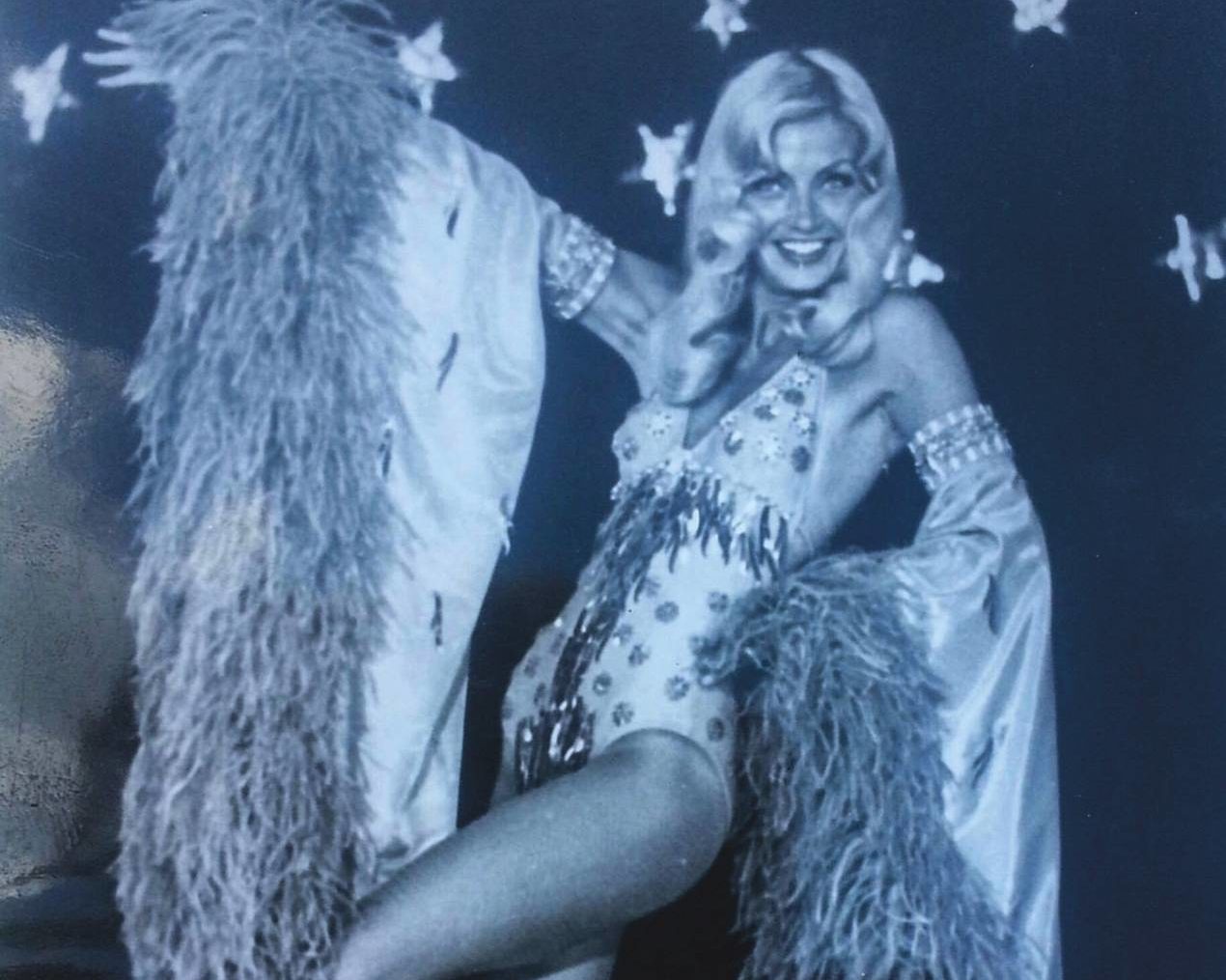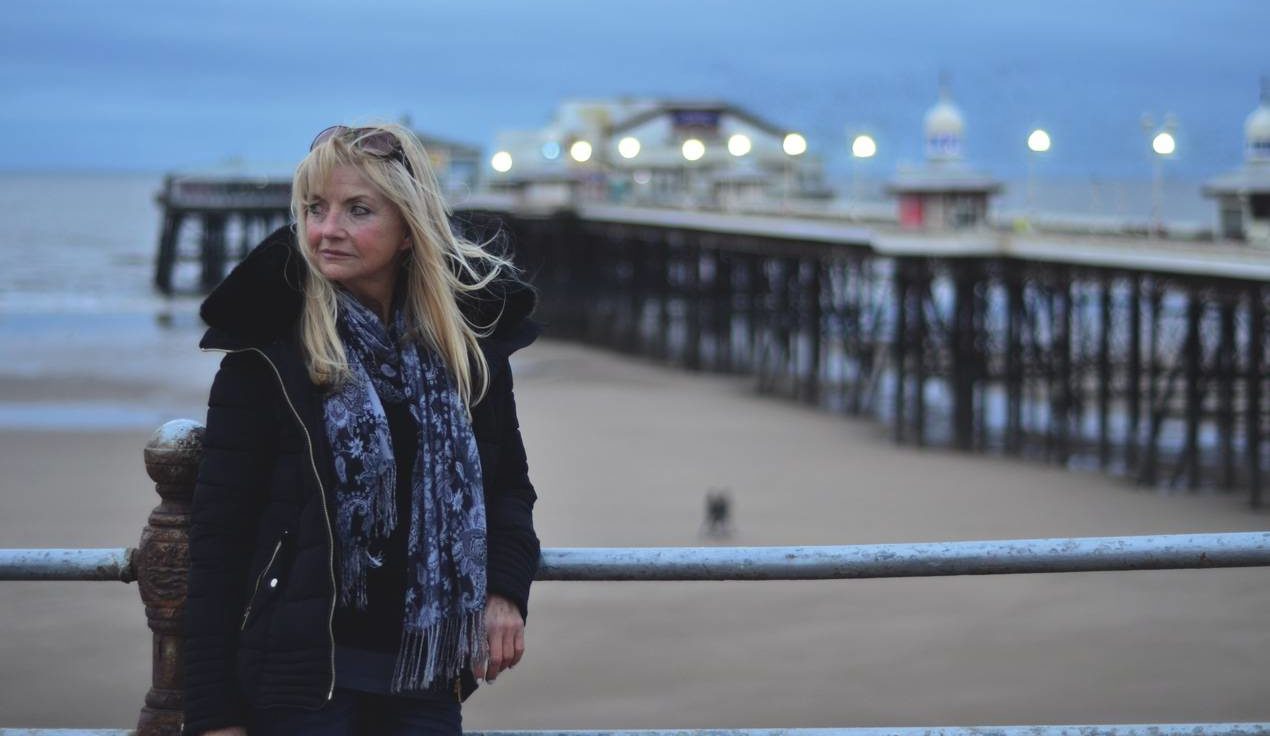Time and tide
As a girl Patricia Lemoine wanted to be just like the glamorous dancers she saw in the circus. Her tale is one of the many stories behind the large-scale portraits popping up around Blackpool
Patricia Lemoine stands in front of the weather-beaten railings before Blackpool’s North Pier, surveying the imposing 500ft steel structure on the other side of the road. But she’s not admiring Blackpool Tower as a feat of engineering or a tourist attraction, but as a landmark of her past – where her career and her great love both began.
“I’ve been around the world and I still love it here,” she muses while a photographer snaps her portrait. “I love this promenade, walking along here, the smell of it, and that wind.”
“We had our dressing room – a hole in the wall at the side of the elephants.”
The photographer is Claire Walmsley Griffiths, and she’s shooting Lemoine as part of her Time and Tide: Retired Performers project. Lemoine was a circusette at Blackpool Tower Circus in the late 1960s and early 1970s – a dancer who would perform alongside acrobats, clowns and exotic live animals. Walmsley Griffiths’ large-scale portrait is one of many being displayed in and around Blackpool landmarks this tourist season and beyond. By sharing the stories outside of a traditional gallery space, and by providing audio interviews via retiredperformers.com, the idea is to share the untold stories of Blackpool’s entertainment heritage with members of the public and visitors to the town.
“The Retired Performers project came about when I was photographing [Blackpool circus festival] Showzam and I came across a lady with a photograph. She was a foot juggler in her late sixties and her husband had been in the Rock and Roll Circus with the Beatles and the Rolling Stones,” says Walmsley Griffiths.
“Other inspiration came from my husband’s great grandma who was a Tiller Girl. All we have of her is a studio portrait and I just think how sad it is that we don’t capture these stories. This is about celebrating this history. If you look around our ballrooms and theatres, they are really aspiring for great things.”
Lemoine remembers Blackpool at “the height of show business”. “It was just a buzzing place. There were so many shows, and as a circusette you were part of the in-crowd. After the shows there was a club where all the artists and all the stars would go, where ordinary people weren’t allowed. It was really fun.”
Growing up, her mother worked in the Tower Circus ticketing office so she would regularly watch shows and admire the dancers. “You’d see these girls walking around in these costumes so every little girl wanted to be a circusette,” she says, remembering how she came to do the job despite having no experience or training. She was working in a brewery when she saw an advert in the paper.
“They wanted tall girls and I wasn’t tall, they wanted dancers and I couldn’t do that, they wanted you to bring a pair of high heels and I couldn’t because I hadn’t a pair, but I thought I’m going to go for that audition no matter what. So I bought a black bathing costume, a pair of tights and I put my hair up. I finished work at four and I got changed in the BHS toilet. In those days you had your eyelashes on anyhow because Twiggy wore them,” she says animatedly.
Fifty years later Lemoine is vivacious and effortlessly entertaining, providing clues to how she managed to win over the judges – “Miss Mary” Daniels and “Mr [Bernard] Crabtree”, then manager of Blackpool entertainment at the Tower, Winter Gardens, Opera House and now demolished Palace Theatre.
After a few weeks of dance classes, costume fittings, and rehearsals, Lemoine found herself “really nervous, but full of adrenaline” backstage on the opening night of the circus season. “We had our dressing room, which was a dump – like a hole in the wall at the side of the elephants. We always had to walk past the elephants. At the time I didn’t, but now I realise what a terrible life those elephants had,” she says as an aside.
The circus hasn’t used animals since 1990, but due to the listed status of Blackpool Tower the stables and pens remain beneath the main arena. During the summer months when Lemoine would perform, it wasn’t unusual to see the elephants being walked along the beach each morning. A more comforting backstage sight for Lemoine was “Auntie Barbara [Barnes]”.

“She was in charge of us girls, making sure we were ready, that our hair was done, and our make-up was right. We were assigned two pairs of tights, fishnets, and we had to learn how to fix them. She had hawk eyes, so we were always careful.
“Between costume changes, you would know exactly how long you had and sometimes you had time to go and smoke in this tiny corner of the dressing room. How stupid!
“The quick changes were something. You had to run off stage and Auntie Barbara would be stood here with our next costume. She’d pull it on, zip us up and we’d be back on. Sometimes a zipper would break but you still had to go on.”
It’s details like this that Walmsley Griffiths is determined to capture in the Arts Council-funded project, ensuring that these unknown stories, which she feels are vital to the town’s entertainment heritage, are not consigned to the past. Another participant whose portrait can be seen is Peter Fielding – a Blackpool musician whose band The Executives supported the Rolling Stones in 1964 at an infamous gig where a riot was incited in the Empress Ballroom. The Rolling Stones were banned from performing there until 2010.
“Everything went bananas with people throwing bottles and coins, and all sorts. People got on the stage and started pulling the gear off, there was screaming and the crowd scattered, they were running for their lives, the bouncers were overwhelmed,” he remembers.
There are also stories of Tiller Girls, ballroom dancers, singers, magicians, redcoats, members of the Roly Poly dance troupe, figure skaters and several participants of the Blackpool Children’s Ballet, which ran for 100 years in the Tower Ballroom and did not accept grammar school children.
Other subjects are associated with entertainers: there’s Frank Lucas, a chauffeur who drove visiting entertainers including Frank Sinatra around the town; Barrie Band, a former entertainment journalist in the town; and Joanne Campbell Smith, whose great-great grandfather was the first musical director of the Blackpool Tower, between 1896 and 1905.
Walmsley Griffiths is most proud of her portrait of Nina Bedini, the foot juggler who inspired the project four years ago. It won’t be displayed as part of the large-scale exhibition however, since she only agreed to be photographed after three years of the photographer persisting, and too late to be part of this initial stage of the project. Walmsley Griffiths is applying for a second round of funding with hopes of attracting more performers and extending the project.
For Lemoine, Blackpool was just the start of the story. She’s back visiting family when Walmsley Griffiths gets the opportunity to photograph her, but she lives in Nordrhein-Westfalen, a German state bordering the Netherlands, with her husband Jean, an entertainer, who came to Blackpool with a plate-spinning act.
“We girls were all sat in the ring watching rehearsals when suddenly this guy came into the middle of the ring, a real big head wearing leather pants and a cowboy hat. I thought wow, but I pretended he was absolutely not interesting to me because all the other girls were looking at him.
“Later of course he asked me out a few times and in the end I said yes. At the end of the season I went with him to Switzerland and we got married. I hardly even knew him. I couldn’t speak German and his English was terrible. So how this has worked I’ll never know. We’ve been married 45 years now.”
The couple have lived a nomadic life of travelling entertainers, with their son Patrick, a juggler who has also performed in Blackpool, in tow. Their credits include four years at the Lido in Paris but Lemoine says the venue she started in is still her favourite. “It’s the most beautiful circus building in the world. There’s nothing like it anywhere else.”
See more of the photographs at retiredperformers.com
